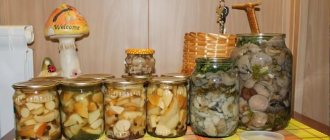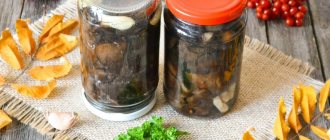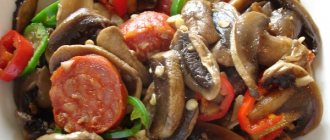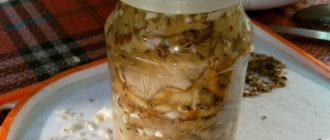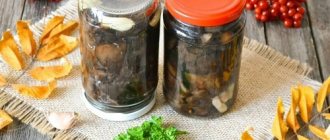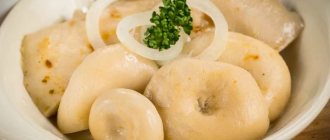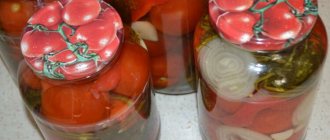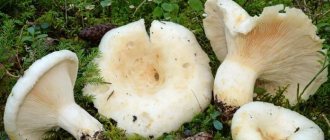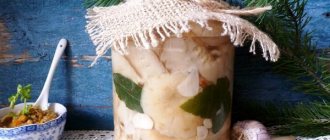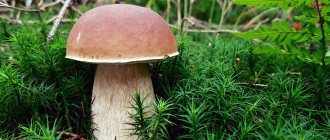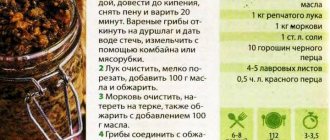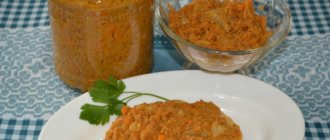The fertile time has come when warm rains trigger the growth of mycelium and you can go on a quiet hunt. And having collected full baskets of nature’s gifts, you have to quickly decide how to preserve the “catch” for the winter. This is where mushroom pickling recipes come in handy!
I used to pickle them more, but after trying my friend’s pickles, I realized that I had missed a lot in my life. Indeed, when salted, this nutritious product is not only a separate dish, but also the main one for soups, casseroles, even your favorite fried potatoes.
Almost all types of mushrooms are suitable for preservation. Gourmets prefer to take exclusively lamellar varieties (milk mushrooms, volushki, honey mushrooms, valui, russula). Although true lovers also harvest tubular ones (boletus, white).
In principle, it is forbidden to harvest only poisonous species in this way for obvious reasons; the rest is a matter of taste.
Stages of preparing mushrooms for pickling
So how to pickle a valuable forest product without spoiling it? Mushroom pickers conditionally divide the whole process into several stages; we will consider them in more detail.
Collection
Naturally, in order to preserve something, you need to prepare the product. That is, you will have to go straight into the forest. But I won’t teach you how to pick mushrooms - everyone has their own secrets and favorite places. Another option is to go to the market and buy raw materials there, but this is not so interesting!
As I already said, lamellar species are best suited for pickling, but if they are not available, all will do, since choosing the ideal mushrooms can be difficult.
Sorting
Next, the raw materials need to be sorted, preferably by variety - honey mushrooms to honey mushrooms, boletus to boletus, chanterelle to chanterelle. Some picky mushroom pickers throw everything into one pile. The main thing is that their taste is not very different.
But I still advise you to spend a little time and do everything honestly, separating the varieties and types. It is especially important to separate the raw materials according to the salting method. So, you can salt saffron milk caps and russula using the dry method. Belyanki, white, volnushki, podgrudki, russula, valui and violin are cold, and the rest are hot.
Cleaning
After sorting, the product should be cleaned of dirt, adhering leaves and needles, debris, and butter and other types with an outer crust - and of it.
The easiest way to clean russula and saffron milk caps is simply to wipe them with a damp cloth or brush them. In rare cases, the product is washed under running water, but then thoroughly dried.
The remaining varieties are washed in a colander or in basins with water, but not for long, very quickly. The fact is that some mushrooms, especially old ones, are easily saturated with water and lose their taste.
The dirty stems of the mushrooms are cut off, in some varieties up to half the length.
Slicing mushrooms
Next, clean “gifts of nature” should be sorted by size, small ones should be left as is, and large ones should be cut into pieces of the same size, but no more than 6 cm.
Some species are distinguished by a large amount of easily oxidized substances (champignons, saffron milk caps, boletuses, boletus), so they quickly darken in the air. To preserve their beauty, you need to prepare a solution (1 liter of water, 10 g of salt and 2 g of citric acid) and after cleaning, throw the mushrooms into it.
Soaking
Many varieties need to be soaked before salting, and the duration of such preparation varies. Eg:
- for valuable species (champignon, white, boletus, oak, boletus) - night;
- for volushka, russula, milk mushrooms about 5 hours;
- violins, black milk mushrooms, valui, bitter mushrooms, characterized by the presence of a large amount of bitterness, will have to be kept in water for up to 5 days, but not less than three.
Naturally, during this time you need to change the water regularly, ideally every 3 hours. But this is not always possible, especially with long soaking and at night.
If the product is very dirty, you can first soak it in salted water (3% salt of the total volume) for 3-4 hours, and then use clean water for the remaining time.
Calculation of the amount of salt
Approximate calculation of salt when salting mushrooms: 50-80 g / kg of mushrooms (about 2 heaped tablespoons).
We recommend reading:
- Smoke exhaust in stationary grills and barbecues
About the benefits of birch sap
Lemon in cosmetics
Methods for pickling mushrooms
At home, you can pickle mushrooms in three different ways - dry, cold and hot. Each has its own characteristics, I advise you to base your choice on the type of mushrooms (I mentioned this in paragraph 2.2).
Hot pickling of mushrooms - recipes
The hot salting method involves heating the raw materials. There are two application options. In both cases, the composition is approximately the same - the main component is salt at the rate of 40-50 grams per kilogram, horseradish, garlic, dill, tarragon, onion.
Recipe No. 1
After soaking and washing, place the raw materials in boiling salted water and boil for 20-25 minutes. You can navigate by the product itself; when ready, the mushrooms sink to the bottom.
Next, they are caught with a slotted spoon, washed with cold water, allowed to drain, and placed in a prepared container, sprinkled with salt and spices. A weight is placed on top to prevent the product from floating. The delicacy will be ready in about a week.
Recipe No. 2
Suitable for boletus, oak, boletus, moss mushroom, white mushroom, honey mushroom. They are boiled in salted water at the rate of 45 grams of salt and a glass of water for each kilogram of raw material. I will add that initially the marinade should only slightly cover the product, since the mushrooms will soon release their juice abundantly.
After this, the boiled product is placed in sterile jars and filled with boiled vegetable oil. The neck of the container is tied with wax paper and lowered into the cellar. With this method you can fry, stew, boil and even pickle!
I will add that when cooking a large amount of product in several batches, the water must be constantly changed, otherwise the last portion will taste bitter.
Cold pickling of mushrooms
The cold salting process is a little easier and faster. For it you need:
- soak the mushrooms according to their type (you don’t have to soak the mushrooms, but simply wipe them);
- take a glass, enamel or wooden container with a large neck so that it is convenient to place pressure;
- wash it, clean it;
- Pour salt onto the bottom, place cherry, currant, horseradish leaves and dill inflorescences on top;
- Place the mushrooms in the first layer with their caps down, then add salt (at the rate of 40 grams per kg of raw materials), spices (peppercorns, garlic, bay leaves), place another layer;
- arrange all the raw materials in this way;
- Place another layer of salt and the remaining leaves on top;
- cover everything with clean cloth;
- cover with a plate or wooden circle;
- Place a pressure on top - a special disk, a jar filled with water, so that the mushrooms do not float, but also do not crush too much. More details about this salting method are described in the video.
If all steps are followed correctly, in a couple of days they will release juice and the brine will cover them. If there is not enough liquid, you need to either increase the load or add a little boiled water.
The pickles will be ready for use only after 1.5-2 months; keep the container in the cold.
Dry pickling of mushrooms
The dry salting method is suitable only for russula and saffron milk caps, since these varieties do not have bitterness and are safe. But it allows you to quickly prepare a “catch” with almost no hassle, and you will be able to eat such pickles in just 1-1.5 weeks!
- Saffron milk caps or russula should be cleaned, wiped with a cloth to remove dirt, and if you still have to wash them, it is important to dry everything well in a colander and towel;
- Next, the raw materials are placed in jars or ceramic dishes with the caps down, sprinkling the layers with salt at the rate of 40 grams per kilogram of product;
- The top of the container is pressed down with a light weight, after three to four days the juice is released and, if desired, you can add a new portion of mushrooms. By the way, the beauty of this method is that you can add new portions of russula or saffron milk caps to one container all season long until it is completely filled.
Choosing containers
To pickle mushrooms, use any clean container. The best, undoubtedly, are oak barrels, which, due to the release of tannins, have a beneficial effect on the storage of the product. If not available, enamel pots and buckets, stainless steel containers, and glass jars are suitable. Plastic containers are a little less desirable, because... may emit an unpleasant specific odor, but this is more likely to apply to new products. Aluminum dishes and galvanized containers are not suitable for pickling.
Mushrooms secrete juice when exposed to salt under pressure. When choosing a container, immediately take care of what you will use to press the pickles. The lid can be a large diameter plate, an enamel or plastic lid from another container, or a wooden board. The main thing is that it covers the pickles completely, leaving only a small gap for the juice to escape.
For oppression, you can use any weight that does not dissolve in water and does not stain it. This can be a well-washed large pebble stone (but brick or limestone will not work), or just a jar, bottle or pan filled with water. The weight of the load depends on the volume of the barrel. Approximate weight calculation 1:10. The purpose of oppression is to press down the mushrooms so that they release juice and prevent them from floating to the surface during further storage.
Recipes for pickling different types of mushrooms
Each housewife has her own secret recipes for pickling mushrooms for the winter. I offer several interesting options, taking into account the variety.
Pickling milk mushrooms is quite popular, since with this method of preparation the product is very juicy, meaty, and crispy. There are two ways to close raw materials - cold and hot.
How to pickle milk mushrooms in a hot way
When hot salting, milk mushrooms do not need to be soaked. The product is simply boiled for 20-25 minutes, and then washed under running water and strained using a colander.
Then the raw materials are laid out in jars or other containers, sprinkled with salt from the already familiar proportion of 40 grams. for every kilogram of product. If desired, you can add spices - dill, garlic, horseradish leaves. In just a week, the pickles will be ready to be tasted.
Step-by-step recipe for cold salting milk mushrooms
Salting consists of the following points:
- soak the raw materials until clean water, changing the water periodically;
- take a clean container with a wide neck;
- put salt on the bottom (in total it should be taken at the rate of 50 grams per kilogram of product), place currant leaves, horseradish, cherries, and dill rosettes on top;
- then lay out a layer of milk mushrooms 6-10 cm thick;
- on top - part of the salt from the total volume;
- again a new layer of fungus, and again salt;
- this is how the entire product is laid out;
- the top is again sprinkled with leaves of fragrant plants;
- Next, a plate or wooden circle is placed, wrapped in gauze, and pressure is applied to it.
How to pickle boletus mushrooms
Boletus mushrooms are salted cold and hot. And if the first, in fact, is no different from what was told earlier, then the second has some features.
So, we need 1 kg. raw materials, 1 l. water, 45 gr. salt, 2 bay leaves, 6 currant leaves, 50 grams of dill inflorescences.
- Peel the boletus mushrooms and boil in salted water (1 teaspoon per liter of liquid) for 30 minutes, skimming off the foam;
- Then drain in a colander, cool, and place in sterile jars along with the spices;
- Each layer of mushrooms is sprinkled with 1 tbsp. salt;
- When all the boletus mushrooms have been distributed, the containers should be filled up to the neck with filtered and boiled solution in which the mushrooms were boiled;
- Next, the jars just need to be rolled up, wrapped and allowed to cool slowly, then transferred to the cold. In this way, boletus mushrooms will be ready in 1.5 months.
Pickling oil
I just love pickled butter, but I only recently learned how to salt them. It turns out that when salted they turn out very tasty.
For 1 kg of raw materials:
- 2 tbsp. salt
- 4 bay leaves
- 5-6 peppercorns
- 2 cloves garlic
- dill in umbrellas or seeds
- a few currant leaves.
- The butter is cleaned, washed, boiled for 20-30 minutes in salted water, and drained in a colander;
- Salt is placed in an enamel bowl, a layer of oil is placed on top of the caps, spices, salt again and a new layer of the same. All the mushrooms are laid out in this way, and on top there is a flat plate and a squeeze from a bottle or jar filled with water.
It is more convenient to store the product in jars, so after a day, when the mushrooms release their juice, they are laid out in these containers and filled with brine so that it completely covers the product. You can also pour a little vegetable oil on top for better storage. And after a couple of weeks in the cold, the pickle will be ready!
Salting the tremors
You can pickle volushki either cold or hot.
Here the cold option is just more interesting, with it:
- you should take 7 kilograms of volushki, 200 gr. salt, 12 gr. citric acid, 50 gr. dill seeds, 20 gr. caraway seeds, a couple of cabbage leaves;
- you need to soak the raw materials in salted and acidified water for three days, periodically changing the liquid;
- combine salt with seasonings;
- place the trumpets in a tub or other container, caps down, in layers of about 6 cm, sprinkling with salt and seeds;
- Place a cabbage leaf on top so that it covers the entire area;
- press down with a disk and a weight;
- leave in the cold for a month or two.
Preserving the benefit
In order to preserve all the beneficial properties of mushrooms, you need to properly process and store them. The two best ways are to salt the mushrooms or dry them. Salted mushrooms are perfectly stored in the cellar or refrigerator for a year, until the next harvest, retaining all the nutrients and excellent appearance.
There are three proven ways to pickle mushrooms for the winter:
- Cold pickling in own juice
- Cold pickling of soaked mushrooms
- Hot salting
Storing salted mushrooms
It’s not enough to know how to make salted mushrooms correctly; you also need to know how to store and use them.
- Pickles should be kept at a temperature of 0 to 6 degrees Celsius. When frozen, the product begins to crumble, and when heated, the fermentation process starts and the product will deteriorate;
- It is necessary to constantly monitor the presence of brine in the container, otherwise the mushrooms may dry out and lose their taste. To avoid this, salted boiled water can be added to the container as needed;
- When mold appears, the fabric covering the pickle is changed, and the pressure is washed, after removing all traces of mold with a dry, clean cloth;
- Well, before cooking, salted mushrooms should be washed with clean water to remove excess salt; some varieties should even be soaked.
Pickling recipes are varied and not too complicated. So the main thing here is to be patient and collect, and then clean all this wealth at home, so that in winter you can enjoy the pickles to the delight of your family and friends. I wish you a successful “silent hunt”, and look for new recipes and tips on our blog!
Seasonings and spices
To flavor the pickles, as well as for their better preservation, add herbs, seasonings and leaves:
- - oak and cherry leaves, which have tannins and promote long-term storage
- - currant leaf, which gives a light aroma of freshness
- - horseradish leaf, which adds a specific aroma and slight spiciness
- - dill umbrellas, which are valued for their bright taste.
Read here - Lemon in cosmetics
For hot brines, aromatic seasonings are used:
- - Bay leaf
- - cloves
- - cumin
- - black peppercorns
- - allspice peas.
Video
An experienced housewife shares her recipe for salting porcini mushrooms in the following video:
The chef offers a recipe for pickling boletus mushrooms in the following video:
About the author:
Found a mistake? Select the text with the mouse and click:
Ctrl + Enter
Do you know that:
One of the most convenient methods for preparing a harvest of vegetables, fruits and berries is freezing. Some believe that freezing causes the nutritional and health benefits of plant foods to be lost. As a result of the research, scientists have found that there is practically no decrease in nutritional value when frozen.
Dry technique
Since you can also use the dry method for salting mushrooms at home, we will consider this option in our review. Only it is not suitable for all varieties, but only for those that do not require soaking. It gets its name from the fact that the prepared ingredients are not even washed, but simply peeled with a knife.
You can use traditional spices for this option. The ingredients are laid out in balls in a wide saucepan or in a jar, previously scalded with boiling water. Each of the layers is sprinkled with salt, for this you need to use more of it, 3-4 tbsp. l. per kilogram of mushrooms. Pressure is also placed on top so that the products begin to release juice. Pickles prepared using this method are usually ready within a few weeks. Ingredients can be added as they arrive.
How to salt milk mushrooms
The recipe for this dish is very simple. To calculate, you need to use basic proportions, for each kilogram you take:
- 3 dill umbrellas;
- 3 tbsp. l. salt;
- 2 bay leaves;
- 2 black peas and 3 allspice;
- 3 cloves of garlic.
To prepare them, you can choose the cold method. It is necessary to soak the ingredients before starting the procedure. If they are small - 3 days, when large - 5 days. Change the water morning and evening to keep it clean.
After the preparatory stage, the milk mushrooms are laid with their caps down, and everything is covered with a load on top. You need to put the prepared container in the refrigerator for a month. And after that they can be distributed into jars, only sterile ones. The brine in which they were located is poured into prepared containers with the product, and a small amount of oil is poured on top. Each jar is covered with a lid and stored in a cool place. This technique is considered the most popular recipe.
Every housewife should also know how to salt milk mushrooms in a hot way. For this you will need mushrooms, herbs, garlic, dill, cherry and currant leaves. For one liter of filling you need 1 tsp. sugar and 3 tbsp. l. liquids.
Sort the milk mushrooms, rinse, cook, cool and place in jars. Add garlic, dill and scalded cherry and currant leaves to each container. Bring the water to a temperature of 100 degrees and dilute sugar and salt in it. Then fill the jars with brine and cover with lids. Use a cool room for storage.
